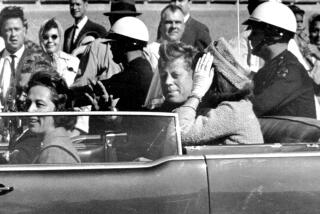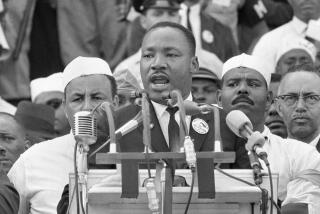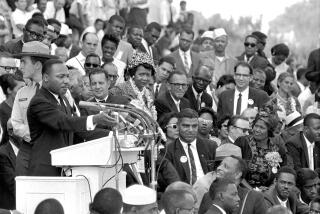Museum Offers Insight Into King Assassination
MEMPHIS, Tenn. — Congressional reports, Justice Department documents and the rifle used to assassinate the Rev. Martin Luther King Jr. opened to public review Saturday at the National Civil Rights Museum.
The detailed multimedia exhibit includes evidence that would have been presented in court against King’s confessed killer James Earl Ray, had the case gone to trial. But the museum also covers conspiracy theories of King’s death and acknowledges some questions still are unanswered.
“I didn’t know there was so much evidence collected,” said Christine Deener, who attended the opening of an $11-million expansion of the museum.
The museum has been housed for over a decade at the Lorraine Motel, and visitors could look into King’s room and peer out on the balcony where he fell mortally wounded on April 4, 1968.
The expansion includes the former rooming house from which the rifle shot was fired--giving visitors a view from the killer’s perspective to the Lorraine balcony.
The .30-06 hunting rifle found outside the rooming house is included, as are personal items Ray left in the room rented under an assumed name.
The exhibit also covers Ray’s many unsuccessful attempts to take back his guilty plea. The plea in 1969 removed the possibility of a death sentence. Ray drew 99 years in prison and died there of liver disease in 1998.
Many museum visitors, even those such as Deener who are convinced of Ray’s guilt, left the exhibit wondering if he was part of a conspiracy.
“We’ll never know,” said Bettye Williams of Springfield, Ill. “He didn’t do it alone, but I don’t know to what degree others were involved.”
The museum tells the story of America’s struggle for civil rights since the days of slavery. The expansion allows that history lesson to continue from King’s slaying to the present.
Benjamin Hooks, the museum’s chairman and a former director of the National Assn. for the Advancement of Colored People, said the expansion shows that much progress toward equal rights has been made since the 1960s, though more work needs to be done.
“This is a day of victory and triumph,” Hooks said. “We celebrate those who have gone without so we might move forward. We stand upon their shoulders.”
More to Read
The biggest entertainment stories
Get our big stories about Hollywood, film, television, music, arts, culture and more right in your inbox as soon as they publish.
You may occasionally receive promotional content from the Los Angeles Times.










